|
The Death of Dr. Martin Luther King, Jr.
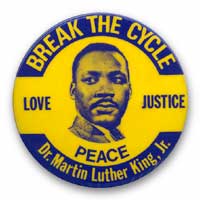
Part I: Riot in Chicago Part II: Funeral in Atlanta
Browse photos of the April 1968 Chicago Riot Aftermath
 On
April 4, 1968 Dr. Martin Luther King, Jr., was assassinated
by a sniper as he stood on the balcony of his hotel room in Memphis, TN. News of his death was greeted with an outpouring of grief and rage. Riots erupted all over the country, primarily in black urban areas. At least 110 cities experienced violence and destruction in the next few days, resulting in roughly $50 million in damage. Of the 39 people who died, 34 were black. The worst riots were in Chicago, Baltimore and Washington, D.C. Over 22,000 federal troops and 34,000 national guard were sent to aid local police -- the largest ever called to deal with domestic civil disturbance. In many cities the devastation was so great that it left a permanent scar, which was still evident decades later. On
April 4, 1968 Dr. Martin Luther King, Jr., was assassinated
by a sniper as he stood on the balcony of his hotel room in Memphis, TN. News of his death was greeted with an outpouring of grief and rage. Riots erupted all over the country, primarily in black urban areas. At least 110 cities experienced violence and destruction in the next few days, resulting in roughly $50 million in damage. Of the 39 people who died, 34 were black. The worst riots were in Chicago, Baltimore and Washington, D.C. Over 22,000 federal troops and 34,000 national guard were sent to aid local police -- the largest ever called to deal with domestic civil disturbance. In many cities the devastation was so great that it left a permanent scar, which was still evident decades later.
 In Atlanta, King's family and his organization, the Southern Christian Leadership Conference (SCLC), arranged his funeral. A controversial public figure, repeatedly praised and vilified, his life had been threatened many times. King himself had said that he did not expect to live a long life. In Atlanta, King's family and his organization, the Southern Christian Leadership Conference (SCLC), arranged his funeral. A controversial public figure, repeatedly praised and vilified, his life had been threatened many times. King himself had said that he did not expect to live a long life.
 Sympathy poured forth from all over the world. In several countries marches were held to honor his memory. In this country, schools were closed in some cities and workers given time off to participate in services and commemorative events. Senator Edward Kennedy chartered a plane to take King's body home. At least thirty planes and one hundred busses were chartered from around the country to bring mourners to Atlanta. On April 9 he was buried in the family plot at South View cemetery; eventually his remains were moved to the King Center for Non-Violence. Sympathy poured forth from all over the world. In several countries marches were held to honor his memory. In this country, schools were closed in some cities and workers given time off to participate in services and commemorative events. Senator Edward Kennedy chartered a plane to take King's body home. At least thirty planes and one hundred busses were chartered from around the country to bring mourners to Atlanta. On April 9 he was buried in the family plot at South View cemetery; eventually his remains were moved to the King Center for Non-Violence.

Part I - Riot in Chicago
 In Chicago, violence erupted in the black ghetto on the west side, eventually consuming a 28-block stretch of West Madison Street. Looting and arson took place primarily in the corridor between Roosevelt Rd. on the south and Chicago Ave. on the north. In Chicago, violence erupted in the black ghetto on the west side, eventually consuming a 28-block stretch of West Madison Street. Looting and arson took place primarily in the corridor between Roosevelt Rd. on the south and Chicago Ave. on the north.
 The next day Mayor Richard J. Daley imposed a curfew on anyone under age 21, closed streets to automobile traffic and banned the sale of guns, ammunition and inflammable materials. About 10,500 police were sent in to protect the fire fighters, soon joined by 6,700 Illinois National Guards. After President Lyndon Johnson ordered 5,000 troops into the city, the General in charge declared that no one, including residents, would be allowed to congregate in riot areas. He ordered his troops to use tear gas against looters; Mayor Daley told the Chicago police to shoot to kill.
The next day Mayor Richard J. Daley imposed a curfew on anyone under age 21, closed streets to automobile traffic and banned the sale of guns, ammunition and inflammable materials. About 10,500 police were sent in to protect the fire fighters, soon joined by 6,700 Illinois National Guards. After President Lyndon Johnson ordered 5,000 troops into the city, the General in charge declared that no one, including residents, would be allowed to congregate in riot areas. He ordered his troops to use tear gas against looters; Mayor Daley told the Chicago police to shoot to kill.
 It took two days to restore order, though some youth bands continued sporadic looting and burning. There were over 125 fires. Eleven people -- all black -- were dead and over five hundred were injured. Almost three thousand persons were arrested. Many buildings were burned to the ground; others were damaged so badly they had to be taken down before they collapsed. The 210 buildings affected were worth roughly $10 million. Power lines and telephone lines were knocked out. At least a thousand people were left homeless.
It took two days to restore order, though some youth bands continued sporadic looting and burning. There were over 125 fires. Eleven people -- all black -- were dead and over five hundred were injured. Almost three thousand persons were arrested. Many buildings were burned to the ground; others were damaged so badly they had to be taken down before they collapsed. The 210 buildings affected were worth roughly $10 million. Power lines and telephone lines were knocked out. At least a thousand people were left homeless.
 The destruction was concentrated on the west side, though there was some in the south side ghetto and the near north side. The south side ghetto escaped the devastation that plagued the west side primarily because two large and well-organized street gangs, the Blackstone Rangers and the East Side Disciples, co-operated in controlling their own neighborhoods. Their leaders did not want to see them ravaged and ruined.
The destruction was concentrated on the west side, though there was some in the south side ghetto and the near north side. The south side ghetto escaped the devastation that plagued the west side primarily because two large and well-organized street gangs, the Blackstone Rangers and the East Side Disciples, co-operated in controlling their own neighborhoods. Their leaders did not want to see them ravaged and ruined.
 The looted stores were largely black stores in black neighborhoods. Much of the looting involved crimes of opportunity; men's clothing stores were particularly hard hit, followed by liquor, furniture, appliances and food. When the riots ended there was a food shortage in the area, barely met by volunteers bringing in food from other areas.
The looted stores were largely black stores in black neighborhoods. Much of the looting involved crimes of opportunity; men's clothing stores were particularly hard hit, followed by liquor, furniture, appliances and food. When the riots ended there was a food shortage in the area, barely met by volunteers bringing in food from other areas.
 Some stores escaped destruction by writing "soul brother" on the windows. While the destruction was selective, some made no sense. A health clinic in Chicago which provided free health care to infants and children was burned to the ground.
Some stores escaped destruction by writing "soul brother" on the windows. While the destruction was selective, some made no sense. A health clinic in Chicago which provided free health care to infants and children was burned to the ground.
 These photographs were taken on Chicago's west side after order had been restored by troops and civilians were allowed to enter the area.
These photographs were taken on Chicago's west side after order had been restored by troops and civilians were allowed to enter the area.

Photos of the April 1968
Chicago Riot Aftermath
by Jo Freeman
Please
click on thumbnails to view the complete image
| |
 |
|
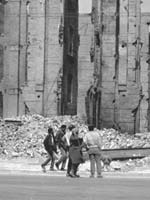 |
Devastation was everywhere |
| |
|
|
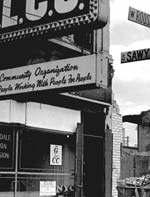 |
|
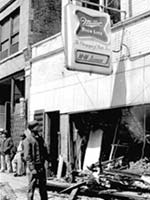 |
Damage was selective
|
| |
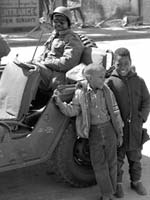 |
|
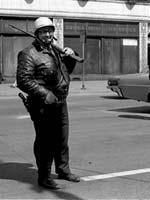 |
Federal troops |
|
Chicago police |
| |
|
|
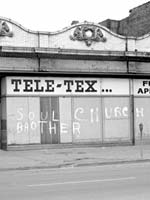 |
|
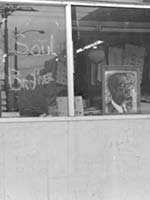 |
"Soul Brother" saves the store
|
| |
|
|
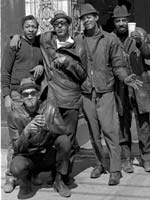 |
|
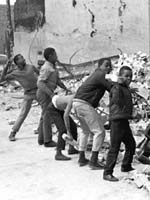 |
Soul brothers |
|
Sons of soul brothers
|
| |
|
|
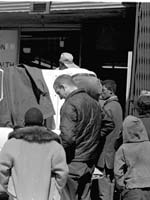 |
|
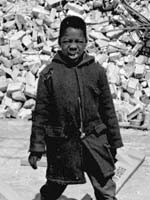 |
Volunteers bring in food...
|
|
...for those in need |
| |
|
|
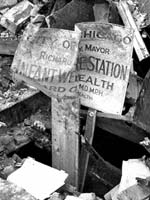 |
|
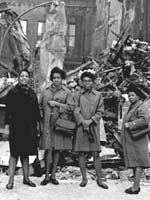 |
Former infant health station
|
|
Former employees examine
what's left of their workplace
|
|
|